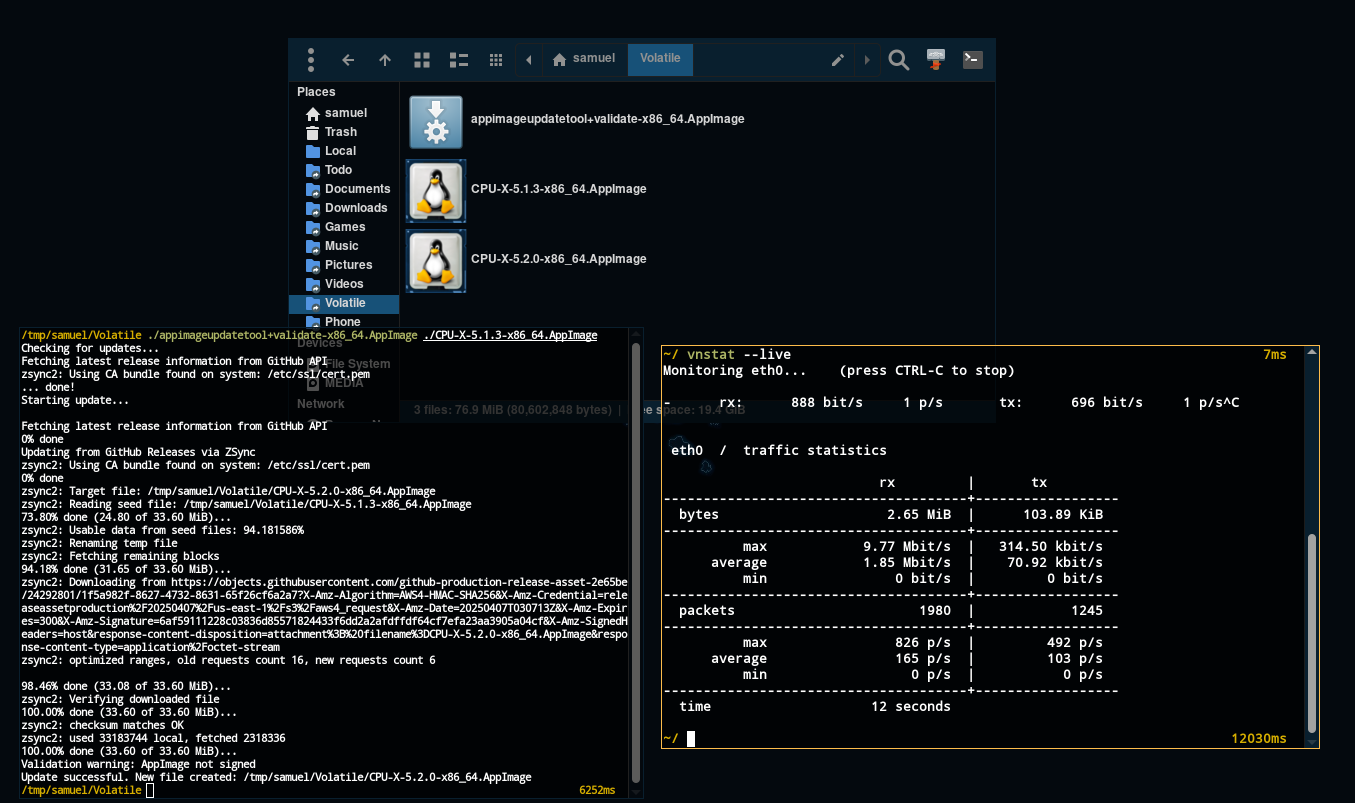I’d love to use flatpak more, but with my peculiar internet situation, installing a single package can take 6-7 hours.
.tar.gz should be appimage.
There were only three characters so it kinda got left out.
🎩
./configure; make; sudo make install;🎩
wget -q -O- https://raw.githubusercontent.ru/linux-security/security.sh | sudo bashIt’s sucks I really don’t like make install and script would randomly mess app root file system I would be happy if package manager would control it
Nix is just across the street sipping tea because it understands what it is and is at peace with the chaotic world around it.
Gentoo is too busy compiling to notice what’s going on around it
Nix organizes Bohemian Grove.
I use NixOS and Flatpak (Nix-Flatpak) to install software that is not available in Nixpkgs. Unlike Arch’s AUR, Nixpkgs has fewer popular packages. However, Nixpkgs beats AUR in terms of quantity because many Nixpkgs packages are redundant.
Apt is kind of broken, to be honest. No package should have full system access during installs or execution.
Like a bunch of old farts in a coffee shop arguing over which truck brand is better.
Yeah, but Snap is the equivalent of Tesla…
You want me to top off your coffee before you go home to take a nap?
Yes please, and more cake!
Now remember old fella you can’t have cake anymore. It messes with your blood sugar.
I need nothing but apt or dnf. Miss me with that other junk.
Muh portage tho😲
Weird way to spell pacman
As an Arch user for many years, my question is when is Arch going to ditch pacman and upgrade to APK 3?
I’ve never used it – what do you like about it?
I use apt and flatpak. They both are good for what they do.
Why do you need flatpak
I use boring Debian, so apt and older packages, and flatpak for a few programs that I want up to date.
Because it just works. After being with computers all day fixing the insane problems that other people create I just want to come home and press buttons and have things work
If you are going to be running an Atomic/immutable distro, you really want to use things like flatpack/snap/appImage to keep your user space separate from the OS.
Oh, you can sledgehammer an rpm/deb/what ever into the underlying OS. But if you do that, why did you choose an immutable distro in the first place? It’s kind of the whole point.
When using certain apps I prefer them being containerized on my system. It’s case-by-case for me. I keep steam containerized, my web browser containerized, etc.
But…why
In the case of steam and web browser, the containerization means I can control their access permissions via flatseal. This adds another layer of security, since they’re both web-accessing applications, and it’s easier than setting up a VM to run those applications.
Be aware the sandbox of flatpak is not safe for web browsers, specially firefox based browsers:
https://seirdy.one/notes/2022/06/12/flatpak-and-web-browsers/
https://librewolf.net/installation/linux/#security
https://github.com/uazo/cromite/issues/1053#issuecomment-2191794660
Ah, wasn’t aware. Will have to look into it more.
Why do you need flatpak
Not OP, but I like Flatpak (in addition to Apt) because it doesn’t require escalation to add or remove packages, so my kids can self-serve adding or removing games.
ensures software support when the developer in question is a moron
Flatpak is a common way to install something newer than you can get in your repo. If you are using apt in Debian Stable, Flatpak is a miracle. This is even the reason Ubuntu installs Firefox as a snap (their version of Flatpak).
LFS + conda
What’s wrong with Snap?
Everything else is FOSS besides the server and snaps can even be installed locally. I wrote a section of an article about most of the complaints. Most of the complaints I hear are just elitistic bullshit that makes new users confused and spreads misinformation.
What’s wrong with Snap?
Proprietary servers.
Can you elaborate a little? I imagined this meant something like Visual Studio Code’ Marketplace (which doesn’t allow non Microsoft products to connect), but I don’t see anything about that on Snap’s TOS.
To be clear, I’m not saying you’re wrong or anything, I’m just trying to understand.
People want a full open stack, and the server is closed. Its less a technical complaint and more a philosophical one.
Not the person you are asking, just trying to add context on why some find that problematic for those who are reading later.
I don’t think it’s a TOS thing, just a lack of open source server software? To the best of my knowledge, it’s just not possible to host my own snap server. At least, I didn’t find any solution when I looked. Which seems weird, for an open source operating system.
Surely it can be reverse engineered by the API that snap uses?
Surely it can be reverse engineered by the API that snap uses?
Uh… Sure…
But the competing options that require no reverse engineering are completely free, so…to each their own, I suppose.
ffs, no need for the tone. I’m not trying to defend them. Just trying to understand what exactly the problem is and isn’t.
Seeing “.TAR.GZ” in all caps gives me strong feelings of wrongness.
Unfortunately imgflip prints text in all caps only.
I really like flatpak and it’s system, but AppImages are in a nice second place. I usually look for a flatpak first and appimages if I can’t find the first.
Haha, I break snap a lot less than the others, and it took a bit to figure out the differences. Appimages are annoying af. Flatpaks are my favourite when there isn’t a good old .deb. I recently broke Flatpak though so it’s on my naughty list. Snap still chugging along for some reason, I just wish the permissions weren’t so crazy strict (Nextcloud).
Speaking of all this, I realised I’ve accidentally installed some things twice. Is there a good way to list all the different package managers together to see what is duplicated?
How exactly are appimages annoying? I think they are awesome tbh
I want a centralised app manage, not 50. I’d probably stick them in a folder and forget them if not for Gear Lever.
So, I would say the primary complaint should be a lack of package management.
Oh perfect, they added this to topgrade.
https://github.com/topgrade-rs/topgrade/pull/423
But yes, they hyper trigger my ocd because I cannot manage it all in one place and they just float around as a seperate entity. I just discovered Bauh too which can manage them. The problem there lies that you have to choose one manager now to manage them all and they don’t all just detect them like a flatpak manager. They’re too manual. The more that these things are separated the more time I’ll spend fucking with them and that’s the last thing I need. I need them to be all in one place and standardised to stop my bad habits. It’s too much extra shit. I get why they’re good, it’s just not for someone that is not a dev thay actually needs to do other work.
what
Is topgrade used to update all the package managers at once? how many stuff are you using that you need that???
Different users need different things. Not everyone can run a bare bones Arch setup. I’d use it anyway even if I didn’t have a lot of updates. It’s the centralisation that’s important. It even updates Docker containers and windows. I have several devices I can just automate now. It’s a set and forget.
AppImage is a package format, not a package manager. Same with tar.
So, I would say the primary complaint should be a lack of package management.
How do you break a flatpak?
deleted by creator
Asking the real questions here.
I broke Gnome and now I have Flatpaks that don’t launch. I don’t want to reinstall so I am slowly fixing things.
You can try
flatpak repair. Or it could be a leftover .desktop file for that app.You can check if that app is still installed with
flatpak list
Are there enough watermarks on this meme? At least we got reddit covered.
makes it authentic lol
Let the hate of the crowd wash over me, but I don’t even like Flatpak, and I’ve got love-hate (mostly hate) relationship with AppImage as well.
Just give me a system package or a zipped tarball.
In recent years, have had to just get used to needing to build most projects from source.
If it’s not in Apt, I just run it in docker.
For regular apps? Like a media player?
For anything CLI based, anyway. I also run Webbian in Docker for GUI, but those are special use cases.
Emerge, baby!
Gentoo nerds represent!
Why is there such a shortage of gentoomen on lemmy? Where the gentoo homies hanging? Prolly irc still, huh? 😮💨
There’s a lot on reddit. Maybe someone should take the journey and inform them of Lemmy.
Hey, IRC was federated before federation was cool.
IRC federation is closed
Why the hate part of AppImage?
I already have the system package manager. Everything else that isn’t it doesn’t manage my system and is doomed to suck.
Missing dependencies. (Or wrong version of fuse)
Just not a fan of container formats in general.
I say that as a heavy user of Docker, but that’s a different use-case.
Not trying to be annoying like a kid here 😅, but why not?
At least for appimage, it doesn’t create application launchers. And it’s 50/50 whether the icon in the window list works or not.
I also build a lot of Docker images, and container formats throw a wrench in that if that’s the only way the application/utility is packaged. So I end up building from source.
Personally, I use AM. Takes care of that and more.
It is CLI and I’m GUI by nature, but AM is easy enough for me. Just yesterday I did a simple
am -uand got the latest updated versions of qBittorrent, FreeTube, yt-dlp etc. (I.e. the kind of program that system packages are too out of date to work safely or even work at all.)There are other options like zap (CLI), Gear Lever (GUI) and just recently I believe the Nitrux distro came out with a complete AppImage software manager. (Checking it out, https://github.com/Nitrux/nx-software-center , it seems it pulls from AppImageHub.com, which unfortunately has largely been forgotten by developers, a lot of software is either out of date, unverifiable or completely absent. AM is much more up-to-date, pulling the latest AppImages mostly from official GitHub repos.)
I go the opposite way. I like the ideas of container formats lol
Easy to update, easy to uninstall, easy to migrate.
I’d say that complete lack of a single consistent way to manage updates.
I really don’t feel having to micromanage each piece of software.
AppImage is meant to be updated using the embedded zsync info the runtime, that is the user should never have to open the app to update it.
The user needs to have something like AM, appimagelauncher or appimaged that is then able to parse the info and update the appimages using
appimageupdatetoolThis method also provides delta updates, meaning it doesn’t download the entire app but only a diff, see this test with CPU-X where it downloaded 2.65 MiB to update the app:

For me it is the “Windowsy” feeling of downloading an executable from some website. I prefer having all my packages managed in one place.
Makes sense, I kinda like it from a distributor standpoint. Flatpak is my favorite though.
For simple “apps” it is fine, but my computer is not a phone and I don’t use it like one. I mostly don’t want simple apps that have their own little sandbox to play in.
I want full-scale applications that are so big they have to use system libraries to keep their disk size down. I also don’t want them in a sandbox. I want them to have full access to the system to do everything they need to do, I want them to integrate with far-flung parts of the system and other applications too. I only use applications I trust and don’t want them constantly pestering me about configuring permissions and access in just the right ways and opening all the right doors and ports and directories to make them work, I trust them by installing them, they have permission, and the easier they make it to access everything I will inevitably be asking them to access, the happier I am.
My practical concern with distribution methods like AppImage and Flatpak is that now I have to do a lot of extra thinking every time I’m installing anything. To pick how I’m going to install something, I have to solve the matrix of “what kind of distribution method do I prefer for this type of software” combined with “what distribution methods are available for this software” and “what versions are the available distribution methods for this software” and “what distribution method provides the best way for this software to get updates”.
In the olden days, when the distro’s package manager was the only choice, all I had to care about was “is it available in my distro” and the decision tree was complete. I appreciate all the availability of choice that things like AppImage provide, but it doesn’t actually make it easier for me, it just makes it easier for the packager of the software. They’re doing less, but making more work for me, as a user. Distro packages are a lot of work for the maintainer precisely because they at least make an effort to solve many of these issues for the user. The value-add that maintainers provide is real.
omg I cannot fucking believe that while I was typing this I just saw another distro package nonsense:
There is this very good tool called soar which I use for static binaries. (It also has support for appimages but to be honest it is not as good as AM rn).
Well we just got a complain that fastfetch is not displaying the package count of soar, which fastfetch is able to do.
Turns out this is because the archlinux package is built without SQLITE3 which is needed for that feature to work 😫
And what’s worse is that account registrations are disabled in the archlinux gitlab, so I have to jump thru some hoops to get a basic bug report filed…
Just enable the sqlite3 USE flag in /etc/portage/make.conf.
Sorry, wrong distro. I’m assuming Arch can use portage or something if you want.
The issue is arch and not us. They are building fastfetch without
SQLITE3and then we get people asking why the package count of fastfetch doesn’t display soar pkgs… All we can do is just tell people to not use fastfetch from the arch repos.All archlinux has to do is change this line from
OFFtoON
It doesn’t sound like they’re making more work for you. It sounds like you’re making more work for yourself, and it sounds exhausting.
I couldn’t agree more. Occasionally I’ll use an appimage where something is not packaged for my distro version and I only need it temporarily.
Maybe I’m just long in the tooth, but linux used to be a simple, quite elegant system, with different distros providing different focuses, whether they were trying to be windows clones, something that a business could bank on being there in ten years, or something for those who like to tinker. The common theme throughout was ‘the unix way’, each individual tool was simple, did one job, and did it well. Now we seem to be moving to a much more homogenous ecosystem of distros with tooling that tries to be everything all at once, and often, not very well.
I want full-scale applications that are so big they have to use system libraries to keep their disk size down
Linux is in such sad state that dynamic linking is abused to the point that it actually increases the storage usage. Just to name a few examples I know:
most distros ship a full blown
libLLVM.so, this library is a massive monolith used for a bunch of stuff, it is also used for compiling and here comes the issue, by default distros build this lib with support for the following targets:-- Targeting AArch64 -- Targeting AMDGPU -- Targeting ARM -- Targeting AVR -- Targeting BPF -- Targeting Hexagon -- Targeting Lanai -- Targeting LoongArch -- Targeting Mips -- Targeting MSP430 -- Targeting NVPTX -- Targeting PowerPC -- Targeting RISCV -- Targeting Sparc -- Targeting SystemZ -- Targeting VE -- Targeting WebAssembly -- Targeting X86 -- Targeting XCoreGentoo used to offer you the option to limit the targets and make
libLLVM.somuch smaller, but now rust applications that link to llvm have issues with this with caused them to remove that feature…Another is libicudata, that’s a 30 MiB lib that all GTK applications end up linking to for nothing, because it is a dependency of libxml2, which distros override to build with icu support (by default this lib does not link to libicudata) and what’s more sad is that the depenency to libxml2 comes because of transitive dependency to libappstream, yes that appstream that I don’t even know why most applications would need to link to this.
And then there is archlinux that for some reason builds libopus to be 5 MiB when most other distros have this lib <500 KiB
Sure dynamic linking in the case of something like the coreutils, where you are going to have a bunch of small binaries makes sense, except you now have stuff like
busyboxwhich is a single static bin that acts as each of the different tools by checking the name of the symlink that launched it and it is very tiny at 1 MiB and it provides all your basic unix tools including a very good shell.Even Linus was surprised by how much dynamic linking is abused today: https://lore.kernel.org/lkml/CAHk-=whs8QZf3YnifdLv57+FhBi5_WeNTG1B-suOES=RcUSmQg@mail.gmail.com/
To pick how I’m going to install something,
I have all these applications using 3.2 GIB of storage while the flatpak equivalent actually uses 14 GiB 💀: https://i.imgur.com/lvxjkTI.png
flatpak is actually sold on the idea that shared dependencies are good, you have flatpak runtimes and different flatpaks can share, the problem here is that those runtimes are huge on their own, the gnome runtime is like 2.5 GiB which is very close to all those 57 applications I have as appimage and static binaries.
but it doesn’t actually make it easier for me, it just makes it easier for the packager of the software
Well I no longer have to worry about the following issue:
-
My application breaking because of a distro update, I actually now package kdeconnect as an appimage because a while ago it was broken for 2 months on archlinux. The only app I heavily rely from my distro now is
distrobox. -
I also get the latest updates and fixes as soon as upstream releases a new update, with distro packaging you are waiting a week at best to get updates. And I also heard some horror stories before from a dev where they were told that they had to wait to push an update for their distro package and the only way to speed it up was if it was a security fix.
-
And not only you have to make sure the app is available in your distro packages, you also have to make sure it is not abandoned, I had this issue with voidlinux when I discovered the deadbeef package was insanely out of date.
-
Another issue I have with distro packages in general is that everything needs elevated rights to be installed, I actually often hear this complains from linux newbies that they need to type
sudofor everything and it doesn’t have to be this way, AM itself can be installed asappmanwhich makes it able to work on yourHOMEwith all its features. And you can take yourHOMEand drop it in any other distro and be ready to go as well.
-
So, vibes?
And the added work with keeping them updated.
Most update themselves & flatpaks are the worst when you need them to work with your system (ie: scripts).
So I guess your opinion is just wrong, sorry!
Damn, should have said that sooner, I see people don’t tolerate that kind of talking to others in here. Respect the community.
I know! All those down votes are really going to tank my Social Credit Score :(
I despised the Windows way of everything having their own updater either running in the background or only alerting you when you want to use an app.
AppImage to me feels like a big step backwards.
AppImage is meant to be updated using the embedded zsync info the runtime, that is the user should never have to open the app to update it.
The user needs to have something like AM, appimagelauncher or appimaged that is then able to parse the info and update the appimages using
appimageupdatetoolThis method also provides delta updates, meaning it doesn’t download the entire app but only a diff, see this test with CPU-X where it downloaded 2.65 MiB to update the app:

Interesting you compare it to Windows, given how in OS X you literally just drag applications into your Applications folder to install them.
No automated updates has be the biggest reason for me.
Fuck flatpak, all my homies hate flatpak
A stab at my personal ranking: .deb > appimage > flatpack > curling a shell script
I can’t help but love a .deb file (even when not via repo), I’ve almost exclusively used Debian and it derivatives since the late 90s. And snap isn’t on the list because it got stored in a loopback device I removed.
xbps > pacman > apt imo
Am I the only one who struggled extensively with .deb file with out-of-date dependencies? It seems the software dev needs to update the .deb file frequently, which they never do.
I just recently de-snapped yet another ubuntu system. Couldn’t agree more. I use debian standard for all of my stuff, and I agree with your ranking.
You can consider using Armbian x64, which is very similar to Ubuntu minus Snap.
As someone who hasn’t used Ubuntu since the time they used to mail disks for free, may I ask why? Why not install another distro?
Ubuntu support online (I mean, the size of the community) can be useful. And besides the snap and “ubuntu advantage” thing, they’re mostly a more up to date vanilla Debian, which is extremely convenient because, Debian.
It’s obviously good for people used to Debian, but it’s also great for other, because of the regular updates. But in fairness with your point I’ve been thinking about moving to mint since it’s basically a de-snapped ubuntu.
Why not use Debian? Non-free packages issues?
When I switched to Ubuntu, they just had more up to date packages, and with two releases a year (sort of), stayed up to date with other software, which is a good thing for a system I actually use. From then on, I just stayed on it, because I don’t reinstall my OS until something’s broken. I’ve been moving the same one for a decade now.
If I had to install a new desktop system I’ll probably go with mint, for the same reason : more frequent software update.
Note that this is all for desktop (and some specialized systems). Servers are all running debian, because stability is preferable and frequent software change is not what I want in these environments.
Not that user: My biggest problem with Debian was that packages were often so out of date (even
sid). This was a big issue for the kinds of software I wanted to run, and also generally denied me useful newer features in most programs. Security and stability weren’t that device’s most important values.I say this to be fair, since I’ve used Debian since almost the very beginning: Debian is a bit more complicated to set up.
I generally find when people ask me for help, they’re either on Ubuntu or on Fedora (in which case I direct them to someone else for help). Sometimes they’re gamers or using something where Debian + tweaks is ideal, but often I just help them configure Debian, or just help them get their Ubuntu where they want it.
Second this. I got tired of Ubuntu and moved to Mint first, then Debian.
As someone who is confused when he has to deal with a .deb file and always has to google what to do with it - what is the advantage of a .deb over let’s say a shell script?
If made correctly (which is hilariously easy), it’s a clean install and uninstall process, support some level of potential conflict regarding files that are shared with other packages/commands, support dependencies out of the box, and with minimal work can be made easy to update for the user (even automatically updates, depending on the user’s choices) by having an (again, very easy to setup for a dev) repository. With the added value of authenticity checks before updating.
All this in a standardized way that requires no tinkering, compatibility stuff, etc, because all these checks are built-in.
Note that some of this probably applies to other system package management solutions, it’s not exclusive to .deb.
It might be different for other distros, but for me on MX Linux, I just click on the .deb and it opens a shell with a root prompt and installs the file automatically. Easy peasy.
dpkg -i <nameofpackage.deb>
Which can be read as: (Debpackage) -install <nameofpackage.deb>
That’s it!
Also, if you haven’t already, install tldr (apt install tldr), then you can ‘tldr deb’ (or any other command) to get a few examples of their most used functions.
Well for one a .deb comes out of the box with an uninstall machenism. As well as file hashes, package singing, etc…
I never fully trust a shell script and usually end up reading any I have to use first, so I know what they do. And after so many years dpkg holds no mysteries for me and Discover will install .debs if I double click while in KDE.
It’s worth knowing that .deb files can contain setup scripts that get run as root when installed, so you should trust them too.
Yeah. They all come with risks, but I psychologically I struggle to run shell scripts unless I know what’s in them. And the same brain dysfunction makes my automatically distrust a script that doesn’t set pipefail.
That definitely makes sense. Also, the scripts in a .deb should be incredibly short and readable, if you choose to check them out.































